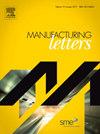开发无线智能传感器系统和起重风险评估案例研究
IF 2
Q3 ENGINEERING, MANUFACTURING
引用次数: 0
摘要
随着工业 4.0 和智能制造概念在各行各业的广泛应用,传感器开发、系统集成和数据分析已成为高效生产运营的重要方面。除了监测机器的性能外,工厂中的人体状态监测也受到了高度重视,通过使用佩戴式传感器来确保工人的健康并预防工伤。本研究介绍了一种体戴式传感器系统的开发情况,该系统能够以高达 400 Hz 的频率对加速度和旋转数据进行采样,并通过蓝牙低功耗 (BLE) 无线传输数据。此外,还介绍了数据采集的通信协议、设备内的数据通信、实时操作系统(RTOS)编程和多线程。该系统的设计方式使多个设备可以同时连接到数据采集(DAQ)系统,并以同步方式从传感器采集数据。这些信息对于在工业领域更广泛地采用传感器系统进行人体状态监测非常有价值。最后,为了测试该系统的能力,介绍了一个起重风险评估案例研究,通过使用不同的机器学习(ML)算法,使用从加速计和陀螺仪收集的数据来确定与人工起重任务相关的物理压力的相对估计值。该案例研究强调了传感器位置、特征提取和传感器类型对机器学习模型的影响。由于传感器系统可以在边缘执行计算,因此提出了一个使用轻量级算法和最重要数据特征进行实时起重风险评估的框架。本文章由计算机程序翻译,如有差异,请以英文原文为准。
Development of a wireless smart sensor system and case study on lifting risk assessment
With the widespread adoption of Industry 4.0 and smart manufacturing concepts across industries, sensor development, system integration, and data analysis have become important aspects of efficient manufacturing operations. In addition to monitoring the performance of machines, significant importance is given to human condition monitoring in factories, using body-worn sensors to ensure the well-being of workers and for injury prevention. This research presents the development of a body-worn sensor system capable of sampling acceleration and rotation data up to 400 Hz and wirelessly transmitting the data over Bluetooth Low Energy (BLE). Further, the communication protocols for data acquisition, data communication within the device, Real Time Operating System (RTOS) programming, and multi-threading are described. This system is designed in such a way that multiple devices can be connected to the Data acquisition (DAQ) system simultaneously, and data is collected from the sensors in a synchronized manner. This information is valuable for the wider adoption of sensor systems for human condition monitoring in industry. Lastly, to test the system’s capabilities, a case study of lifting risk assessment is presented, where data collected from the accelerometer and gyroscope are used to determine a relative estimate of the physical stress associated with a manual lifting task by using different machine learning (ML) algorithms. The case study highlights how sensor placement, feature extraction, and sensor types influence machine learning models. As the sensor system can perform computations on the edge, a framework to carry out real-time lifting risk assessment using lightweight algorithms and the most important data features is proposed.
求助全文
通过发布文献求助,成功后即可免费获取论文全文。
去求助
来源期刊

Manufacturing Letters
Engineering-Industrial and Manufacturing Engineering
CiteScore
4.20
自引率
5.10%
发文量
192
审稿时长
60 days
 求助内容:
求助内容: 应助结果提醒方式:
应助结果提醒方式:


